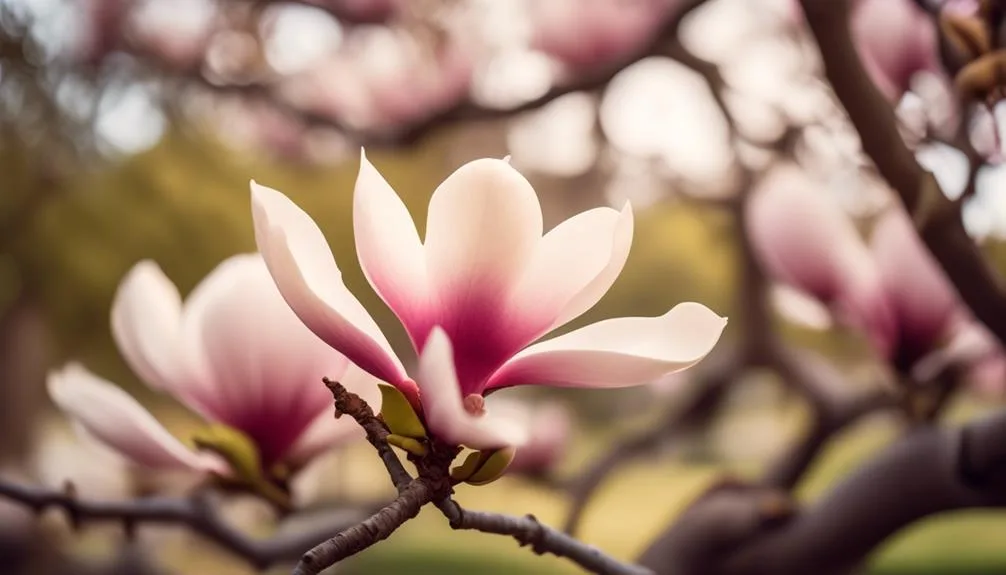Magnolia trees do more than just look pretty – they're essential for our local environment. These majestic trees enrich the soil and provide homes for wildlife, making them vital for our ecosystem.
But there's more to discover about how magnolia trees help our local environment.
Soil Enrichment
To improve the health and fertility of the soil around your magnolia trees, consider enriching it with organic matter such as compost or well-rotted manure.
Nutrient cycling is essential for soil health, and organic matter plays a pivotal role in this process. When you incorporate compost or manure, you're enhancing the soil structure, allowing for better water retention and aeration. This creates an ideal environment for microbial activity, which is crucial for breaking down organic matter and releasing nutrients that are then made available to the magnolia trees.
The organic matter also acts as a food source for beneficial soil organisms, further promoting a healthy and diverse soil ecosystem. By enriching the soil in this way, you aren't only supporting the growth and health of your magnolia trees but also contributing to the overall vitality of the local ecosystem.
Wildlife Habitat
Enriching the soil around your magnolia trees with organic matter not only supports their growth and health but also creates a thriving habitat for a diverse range of wildlife.
The leaf litter and natural mulch provide shelter and food for various insects, which in turn attract insect-eating birds like warblers, chickadees, and woodpeckers.
The dense foliage of magnolia trees offers ideal nesting sites for birds, providing protection and camouflage for their nests.
Additionally, the fragrant flowers of the magnolia tree attract pollinators such as bees and butterflies, contributing to the overall health of the local ecosystem.
The presence of these pollinators not only benefits the magnolia tree but also supports the reproduction of other plant species in the area.
Thus, by cultivating magnolia trees, you inadvertently foster a vibrant wildlife habitat in your surroundings.
Air Quality Improvement
Improving the air quality in your local environment can be achieved by planting magnolia trees. Magnolia trees are known for their ability to filter pollutants and release oxygen into the atmosphere. They play a crucial role in carbon sequestration, capturing and storing carbon dioxide to mitigate climate change.
Magnolia trees have broad leaves and dense foliage, which act as effective filters. They trap particulate matter and pollutants, enhancing the overall air quality. Additionally, the presence of magnolia trees contributes to climate regulation. They help reduce the urban heat island effect through shading and evapotranspiration.
Erosion Prevention
Planting magnolia trees along riverbanks and hillsides can effectively control erosion and preserve the stability of the local ecosystem. The roots of magnolia trees play a vital role in preventing erosion and maintaining the integrity of the soil.
Here's why magnolia trees are crucial for erosion prevention:
- Erosion Control: The extensive root system of magnolia trees helps to bind the soil together, reducing the risk of erosion caused by water runoff and wind.
- Root Stabilization: The strong, deep roots of magnolia trees anchor the soil, preventing it from being washed away during heavy rains or flooding.
- Protection of Riverbanks: Magnolia trees planted along riverbanks act as a natural barrier, reducing the impact of water flow and minimizing soil erosion.
- Preservation of Hillsides: By planting magnolia trees on hillsides, the roots help stabilize the soil, preventing landslides and erosion.
The presence of magnolia trees is essential for maintaining the structural integrity of riverbanks and hillsides, ensuring the preservation of the local ecosystem.
Aesthetic Appeal
Enhance the scenic beauty of your surroundings with the captivating presence of magnolia trees, adding a touch of natural elegance to the local ecosystem.
The cultural significance of magnolia trees lies in their botanical beauty, which has been admired for centuries. Their large, fragrant flowers and glossy evergreen leaves make them a popular choice for urban landscaping, providing a sense of seasonal charm with their stunning blooms.
Magnolia trees not only contribute to the visual appeal of an area but also uplift the overall ambiance, creating a serene and picturesque environment. Their timeless beauty has made them a symbol of purity and dignity in various cultures, further enhancing their allure.
With their graceful form and lush foliage, magnolia trees effortlessly elevate the aesthetic appeal of any landscape, making them a cherished addition to local ecosystems.
Conclusion
So, next time you spot a magnolia tree, take a moment to appreciate its vital role in the local ecosystem.
From nurturing the soil to providing shelter for wildlife, these trees contribute to a healthy environment.
Their natural beauty enhances the surroundings while supporting a thriving ecosystem.
Let's cherish and protect these magnificent trees for the well-being of our world.

My interest in trees started when I first saw the giant sequoias in Yosemite.
I was a teenager then, and I remember thinking, “I need to learn more about this.”
That moment stuck with me.
A few years later, I went on to study forestry at Michigan Tech.
Since graduating, I’ve worked in a mix of hands-on tree care and community education.
I’ve spent over ten years helping people understand how to plant, maintain, and protect the trees in their neighborhoods.
I don’t see trees as just part of the landscape.
They are living things that make a real difference in our daily lives.
